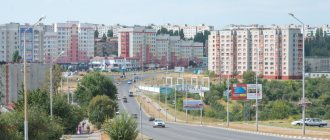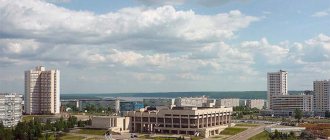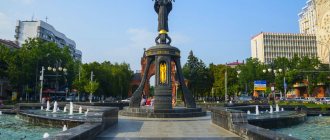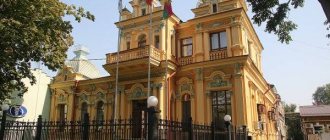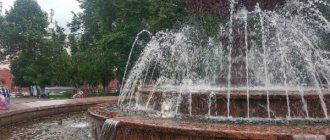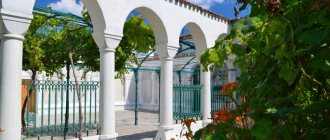General information and history of Sarapul
Sarapul is one of the oldest cities in the Kama region, a city located in the southeastern part of the Udmurt Republic, on the right bank of the Kama River.
The distance to Izhevsk is 62 km, to Moscow – 1250 km. A village called Sarapul appeared in 1707, and city status was received in 1780. A fairly favorable geopolitical and geographical location helped Sarapul gain the unofficial status of one of the most successful cities in the Kama region.
Sarapul. View of the city center from the Kama River
Sarapul is home to a large number of architectural monuments. Previously, the city had 33 churches and 2 monasteries. Currently, the Church of the Ascension, Intercession and Xenia of St. Petersburg have been preserved.
Ascension Church
Today Sarapul is a major industrial center of the Udmurt Republic. The joint-stock enterprises radio and electric generating plant are the industrial face of the city.
Father of the legendary cavalry maiden Nadezhda Durova
Mayor Andrei Vasilyevich Durov is one of the most famous residents of Sarapul in its entire history.
In Russian history, Andrei Vasilyevich is best known as the father of Nadezhda Durova, the legendary cavalry maiden. For Sarapul, the mayor was the true father of the city, who did a lot for its improvement and prosperity. Vyatka nobleman, participant in the Russian-Turkish wars A.V. Durov was appointed by the governing Senate to the post of mayor of Sarapul in 1789 and held this position for 36 years.
Under him and with his assistance, the first educational institution - the Small Public School - and the first city hospital with 11 beds were opened in Sarapul, local merchant dynasties and the city-forming leather industry were born, the first stone buildings appeared, and urban development took shape. Thanks to the mayor, in 1802 the main temple of the then Sarapul, the Ascension Cathedral, was dismantled to its foundations and re-erected, having significantly expanded.
Climate and ecology of Sarapul
Sarapul is located in a zone of temperate continental climate (consistently hot summers, consistently cold winters and low precipitation). The average annual temperature is +3.4 °C (in summer the thermometer can rise to +36 °C, and in winter it can reach -34 °C). The average annual wind speed is 3.1 m/s, and air humidity reaches 69.7%.
Winter in Sarapul
The ecological state of the city cannot be called terrible, but it does not qualify for an “excellent” rating. The main sources of air pollution include public utilities, metalworking and machine-building enterprises, as well as enterprises specializing in the food industry.
As for reservoirs, the most polluted rivers are the Kama and Bolshaya Sarapulka. They are negatively affected by such enterprises as the Sarapul Machine-Building Plant, a poultry factory, a meat processing plant and a radio plant. Sources of pollution also include household waste dumps growing in the south and west of Sarapul.
Population of the city of Sarapul
At the beginning of 2014, 99,869 people lived in Sarapul. The city is multinational: 82% of the population are Russians, 9.2% are Tatars, 3.8% are Udmurts, and the remaining 5% of the population accounts for more than sixty nationalities.
Day of the city
It is worth noting that the mortality rate in Sarapul (as well as in the Udmurt Republic as a whole) exceeds the birth rate. There are often cases when residents leave the city, moving to larger settlements, which, together with the previous factor, leads to a decrease in the city’s population.
The level of education and morality in the city is high, because there are many different educational institutions in Sarapul. In addition, in 2010, the Public Council of the Municipal Municipality “City of Sarapul” was organized, which included representatives of 20 associations and public organizations of the city. At the same time, the total number of public organizations reaches 40 (trade unions, religious, national-cultural, veterans, etc.).
Sarapul
Sarapul as a settlement arose during the penetration of the Russian population into the territory of the Middle Kama region after the capture of Kazan in 1553, when settlement of the Kama banks became possible. It was first mentioned in 1579 in the census books of the North Kama region, where the flight of peasants “to Sarapul” is noted, and also in 1616 in the context of describing the unrest of local peoples inhabiting this area, which indicates a complex ethnopolitical situation at that time associated with active colonization of the region by the Russian population. For a long time, local residents supplied live sterlet to the imperial table. Therefore, the most popular version among residents is that the Turkic name for sterlet “sara-pul” gave the name to the city. But from a historical point of view, it is considered more correct to form this word from the Komi “sardiz” or the Udmurt “zarez”, which means “water” and “pavel” - village or settlement.
The location of Sarapul in the early stages of its existence was limited by two tributaries of the right bank of the Kama River - the Sarapulka and Yurmanka rivers. It is here that one should look for that section of the Kama bank where the first huts of Russian settlers appeared. Later, a fortress will grow on this site.
The fortress, known from the image of the coat of arms of the city of Sarapul, existed during a certain and fairly short historical period. Historical materials indicate the time of its construction under Peter the Great. The fortress, which personified the strength and power of the Russian State, became a symbol of its presence on the distant eastern outskirts and did not exist for long, became the compositional core of the city's development. It is no coincidence that it also became a symbol of Sarapul, entering the heraldry of Russian cities. Descriptions of the Sarapul fortress, and therefore the settlement itself, made by participants in the first academic expeditions are known. The fortress structure stood for less than a century, and was demolished at the end of the 18th century, when a city square was laid out on the site of the fortress.
The first surviving written mentions of Sarapul date back to the 16th century. The earliest source is the scribe book of the Moscow hundredth scribe I.I. Yakhontov for 1579, which describes the flight of peasants from the Perm lands “to Sarapul”. The Census Book of 1596 states: “In the Kazan district, up the Kama River, on the Osinsky settlement, Novo-Nikolskaya Sloboda... In the settlement there is fishing and hops and beetroot; along the Kama River and along other rivers - along the Tulva and Ochera; in Sarapul and Siva they catch fish from dues and their Permyak hops are taken from Osa, down the Kamaya River to the White Voloshka...” The Watch Book of 1621 attests that in the village of Voznesenskoye, “...on Sarapul...”, there are 132 households. The village was located at the intersection of water and land routes and was of great strategic importance. The tsarist government used it as a stronghold to suppress riots and unrest of the colonized population from national minorities.
From the notes of Captain N.P. Rychkov, traveler and geographer, about the palace village of Sarapul in 1770: “...The palace village, called Serapul, is such a residence that both in the structure of philistine houses and in the wealth of its inhabitants surpasses many county towns. The buildings of the same village consist of 3 wooden churches, built inside a wooden castle, and 600 peasant households. Wealthy Sarapul residents have tanneries and soap factories, and both the yuft they make and the soap are sent by water to the noble cities of the Russian state... But the most profitable ship shipment of the Sarapul residents is firewood, with which, having filled huge ships, they are sent by water to Astrakhan and other treeless places within located in this province... The village of Sarapul is the initial place in this volost of this name: for in it there is a steward and a court established for the peasants. Under the authority of this volost government there are many villages and hamlets in which more than 15 thousand souls are considered males...” Sarapul was rich, abundant, and crowded by the standards of that time. Its main decoration is a “wooden castle”, with which “this place is worthy of note,” as stated in the description of the coat of arms. Among the wooden churches in the fortress there was the main one, in the name of the Ascension of the Lord. She gave the second, Russian, name to the settlement - the village of Voznesenskoye.
Gradually the settlement was upset. Although most of the Sarapul residents were engaged in farming and fishing, there were also plenty of artisans. Until 1729, the population of Sarapul was governed by governors, and since 1729, palace managers were sent from the institutions of the palace chancellery. Since 1740, in connection with the establishment of a palace office in Kazan, the village was renamed the palace settlement (village) Sarapul, and the managerial position began to be entrusted to local residents.
By the middle of the 18th century, attempts by the indigenous inhabitants of the Middle Kama region to maintain control over this territory were finally stopped. But there was no stability. Popular discontent with the state's policies towards the peasantry and non-Russian peoples, which had reached its peak by that time, resulted in a peasant war, and from December 1773 to July 1774, the village of Sarapul found itself in the area of the Pugachev uprising. The uprising of the peasants of the volost was led by Yakov Zylev, a peasant of the Sarapul palace volost, the Pugachev ataman. In February 1774, government troops took Sarapul and the settlement again became a pro-government stronghold. After the upheavals caused by the uprising, the population of the region returned to the rut of peaceful life for a long time; many Sarapul residents went to live in other places.
A new page in Sarapul history began during the reign of Empress Catherine II. The Pugachev uprising showed the need to strengthen central power locally. Frightened by the rebellion, the empress began to carry out provincial reform. By the Senate decree of September 11, 1780 “On the establishment of the Vyatka governorate of 13 districts,” the palace settlement of Sarapul received the status of a city, which became the center of the Sarapul district of the Vyatka governorate (from 1797 - the Vyatka province). The district included the Izhevsk and Votkinsk factories. In 1781, the Coat of Arms of the city of Sarapul was approved, designed by A.A. Volkov, the court herald of Catherine II. “At the top of the shield is the coat of arms of Vyatka; in the lower part, in a silver field on a high mountain, there is a wooden chopped city, the building of which makes this place worthy of note,” this is how the coat of arms of the district city of Sarapul is described in the Code of Laws of the Russian Empire. On August 13, 1784, Catherine II approved the first master plan for the development of the city: “Plan of the Vyatka Governorate for the City of Sarapul.” According to the plan, the city's territory extended from the Yurmanka River to the Sarapulka River. There were 3 streets parallel to the Kama River (Bolshe-Pokrovskaya, Vyatskaya, Troitskaya), and 7 streets perpendicular (Tikhonovskaya, Nikolskaya, Malo-Pokrovskaya, Nagornaya, Bogoyavlenskaya, Voznesenskaya). The central place of the city became the spacious Cathedral Square. On the western side the city is surrounded by an earthen rampart and a moat.
Sarapul's acquisition of the status of a county town radically changed the course of its life. In a relatively short period of time, the rural settlement acquired the features of a county center. Public offices functioned in the city: the district treasury, the lower zemstvo court and the lower reprisal. The mayor was at the head of the city, and the police captain was appointed head of the district. Sarapul at that time was a settlement consisting of 406 philistine houses, with two churches (a stone cathedral and a wooden parish). Handicraft production of soap, leather, sheepskin, and footwear developed rapidly in the city. In 1791, there were 11 artisanal tanneries in Sarapul. In 1812, a second general plan for the city was created, which provided for the formation of new residential areas in the western part of the settlement, while in the southern part it was planned to create a kind of industrial zone. The reform of the education system that began in the country at the end of the 18th century was expressed in the creation of a network of public schools. On September 22, 1790, with the assistance of the mayor Andrei Vasilyevich Durov, the first “small” public school of the Vyatka province was opened in Sarapul. The duration of education for children was 2 years. Students learned writing, reading, grammar rules, arithmetic and drawing. For 10 years, Vyatka Seminary graduate Alexander Ivanovich Veshtomov, the first Vyatka historian and botanist, served as a teacher at the school. A new impetus to the growth of the city, the development of crafts and trade was given by the government Decree on the transfer from 1805 of the palace peasants to the rank of state peasants, with the right to freely transfer them then to the merchants or philistines. Almost all the former peasants of the city took advantage of the opportunity that opened up to become merchants or philistines. All merchants, depending on the size of the declared capital, were divided into 3 guilds. The lower the rank of the guild, the fewer rights the merchant had and the more restrictions he had on trade. After the fishing tax reform in 1863-1865. the number of merchant guilds was reduced to two. The category of a guild certificate began to be determined not by the size of the declared capital, but by the type of entrepreneurial activity. The certificate of a merchant of the 1st guild gave the right to wholesale trade in Russian and foreign goods, and the certificate of a merchant of the 2nd guild gave the right to retail trade. The names of Sarapul merchants were known far beyond the city: Bashenins, Zylevs, Peshekhonovs, Bodalevs, Smagins, Dedyukhins, etc. The well-being of the local population was directly dependent on the leather and textile industries. The oldest tanneries were opened in 1823, 1830, 1835, 1840. Gradually production developed, craftsmen began to make “red” yuft, and “Sarapul goat” boots were famous. Shoes were sold at rural bazaars and fairs in big cities - Irbitskaya, Nizhny Novgorod. In 1868, there were 30 tanneries in Sarapul. According to the writer and scientist N.N. Blinov, in the sixties and further years of the 19th century, trade expanded so that sewn shoes were not enough to satisfy the demand for them: “... while waiting for the goods to arrive, buyers lived in the city for a week.” To improve the quality of shoes, Sarapul industrialists tried to introduce new technologies. In 1907, Peshekhonov’s mechanical shoe factory was opened in Sarapul. According to the City Regulations, the Sarapul City Duma, a body of city self-government, was created and began work on February 3, 1872. The vowels (members) of the Duma were elected from representatives of the bourgeoisie and partly from the local bourgeois intelligentsia. The Duma was headed by the City Mayor. The permanent executive body was the City Government. Its terms of reference included: maintaining family lists of merchants, townspeople, honorary citizens, draft lists, lists for the quartering of militias, issuing building permits, renting city buildings, distributing night guards, etc. According to the results of a census carried out on behalf of the Duma in the city of Sarapul in 1873, there were 10,125 people, 5,325 men and 4,800 women. By class, the inhabitants were distributed as follows: 106 nobles, 291 officials, 464 merchants, 5302 burghers, 2714 peasants, 1031 lower military ranks, 216 commoners.
In the XIX - early XX centuries. Sarapul was not only the administrative center of its district, but also the center of its social and cultural life. New educational institutions, cultural and educational institutions were opened here, and various charitable societies were organized. The definition of “first” is perfectly suited to Sarapul. Many institutions that opened here were of a central nature and were the first on the territory of modern Udmurtia. In 1811, a city hospital with 15 beds was opened in Sarapul, subordinate to the order of public charity; in 1868, the hospital was transferred to the subordination of the Zemstvo. In 1866, merchant Starkov A.A. A printing house was opened in Sarapul. The company had 1 press, 1 lithographic and 2 printing presses. Mostly trade invoices, labels, forms for business activities, magazines and reports of the city duma, etc. were printed. In 1860, the first Sarapul women's parish school for people of the “middle class” was opened, reorganized in 1881 into a gymnasium. In 1882, in connection with the opening of the 8th pedagogical class, the Sarapul Women's Gymnasium became one of the main centers for training teachers of primary schools and colleges of various departments.
On January 1, 1835, on the initiative of the district doctor Kh.I. Chudnovsky and with the permission of the Minister of Public Education S.S. Uvarov, the first public library in the Vyatka province was inaugurated in Sarapul. 356 copies of books and 330 rubles worth of visual aids on various sciences, arts and industry were donated for the library. The library has a scientific office on natural science, history, physics, technology and other branches of knowledge. By the beginning of the 20th century, several more public libraries and reading rooms appeared in the city. On February 11, 1873, a real four-year Alekseevsky School was opened to train qualified technical specialists. In 1894, a branch of the State Bank of Russia was opened in Sarapul, since the city Public Bank, which had existed since 1869, no longer satisfied the demands of industry and trade.
In 1909, the Sarapul Zemstvo Museum was established. Among the founders was entomologist L.K. Krulikovsky, handed over his personal collection of butterflies and insects, numbering 18 thousand specimens, to the zemstvo doctor F.V. Streltsov (donated manuscripts on the history of the region), ethnographer N.E. Onchukov (donated a collection of folk songs and fairy tales), priest N.N. Blinov (donated his personal library). In 1913, the Museum was reorganized into the Sarapul Museum of the Society for the Study of the Kama Region. Evidence of the city's increased status was the presence of institutions of a district nature. In 1831, the Sarapul branch of the Vyatka Appanage Office was opened for six appanage orders of the region, in 1863 it was transformed into the Sarapul Appanage Office, operating in the territory of the Vyatka, Kazan, Ufa and Perm provinces. The opening of the District Court in the city on July 1, 1874, with the expansion of its area of activity to the Sarapul, Yelabuga, and Malmyzh districts, was evidence of the increasingly increasing role of Sarapul in the Kama region. One of the best buildings in the city, located on the corner of Cathedral Square and Pokrovskaya Street, was proposed to house the court. Currently, the city administration is located in this building. Sarapul was not only one of the important administrative and trade centers of the Middle Kama region, but also its “spiritual capital”. The city was decorated with Orthodox churches: the Ascension Cathedral, the Intercession Church, the Trinity Church, the Resurrection Cemetery Church, the Peter and Paul Church, Edinoverie churches (St. George Cemetery and Nikolaevskaya), churches of monastic parishes (St. John the Baptist and Annunciation churches), there were house churches and prayer houses. Sarapul was first the center of the Sarapul vicariate of the Vyatka diocese, and since 1918, the governing bodies of the independent Sarapul diocese, which united church parishes located on the territory of Yelabuga, Malmyzh, and Sarapul districts, were located here. In the city for almost 100 years, starting in 1820, there was a theological school for the training of clergy. Thanks to the generous donations of merchants, there were charitable institutions in the city, such as the Alexander House of Charity for the Poor, the widow's house of U.S. Kurbatov, almshouse named after. I. S. Kolchina, a refuge for poor children, a home of hard work. In 1875, the Sarapul Charitable Society was formed, which provided assistance to poor residents of the city, provided benefits to poor students of real and district schools, gymnasiums and other educational institutions, maintained free canteens, etc. The society's funds consisted of private donations and membership fees , deductions from the city and zemstvo budgets, fees from charity performances. By decision of the Sarapul City Duma of March 28, 1886, names were given to the streets designed in the factory settlement behind the Sarapulka River according to the new city plan. Streets running parallel to the street. Meshchanskaya (now Proletarskaya Street) shall be named: Kuznetskaya, Dubrovskaya, Ozernaya, Zavodskaya, Amurskaya. The alley opposite the Bodalev plant - st. Lugovaya. The street above the street. Vladimirskaya (now Sedelnikova Street) should be called Yurmanskaya. Streets running from north to south and located further than st. Smolenskaya (now Nekrasova Street), named: Dachnaya, Lesnaya. According to the All-Russian Population Census for 1897, 21,395 people lived in Sarapul. In the pre-revolutionary history of our city, merchants played a dominant role. Sarapul merchant of the 1st guild, City Mayor in 1902-1910, Pavel Andreevich Bashenin, over the years of his leadership, turned Sarapul into one of the most dynamically developing cities in the province and Russia. He tried to link the solution to the urgent problem of the city, which has great needs for water, with the creation of a power plant. In 1910, the city water supply system was put into operation and the city power plant was launched. The development of the city's economy was favorably affected by its proximity to the Kama River; river navigation connected Sarapul with the all-Russian market. The lack of modern land-based year-round communication routes hampered the development of industry and trade. P.A. Bashenin actively sought to establish a railway connection through Sarapul. In 1912, the Council of Ministers approved the project of the Kazan-Sarapul-Ekaterinburg railway line, developed by the Moscow-Kazan Railway Society. Freight traffic opened on some sections of the road in 1916. Due to the location of the city of Sarapul at the intersection of two transport routes: railway and water, it becomes the center of freight traffic in the Middle Kama region; cargo exchange between Central Russia and Siberia began to occur through the city. In 1918, a section of the railway line was built from Kazan to Sarapul, with a branch from the Agryz station to the Izhevsk and Votkinsk factories. After the October Revolution of 1917 took place in the country, the life of the former merchant city changed dramatically. By a resolution of the executive committee of the Council of Workers', Soldiers' and Peasants' Deputies dated March 10, 1918, the Sarapul City Duma and the city government were dissolved. At the beginning of April 1918, Soviet power was established throughout the entire Sarapul district. Privately owned industrial enterprises were nationalized, and the organization of Soviet authorities and administration in the city began. On December 22, 1937, our city became part of Udmurtia.
The contribution of Sarapul residents to the victory in the Great Patriotic War was also significant. 25 natives of the city and region were awarded the title of Hero of the Soviet Union. The city gave up about 10 thousand of its sons and daughters to the war. The largest factories from Moscow, Leningrad, and Baku were evacuated here. All the best buildings were given over to house 8 evacuation hospitals.
From 1945 to the present – industrial center of the Ural region
The phrase “the first in Udmurtia” is very suitable for Sarapul - this is the opening of the first zemstvo hospital in 1811, and the first public school in 1790, the first post office - 1831, and a women's gymnasium in 1860, a public zemstvo library in 1835, the first fire brigade in 1852, the first printing house in 1866, the first public film show took place in 1897, music classes and a museum began operating in 1909, and the first drama theater in 1911.
Nadezhda Andreevna Durova, the first female officer awarded the St. George Cross for her participation in the war with Napoleon, lived in our city for 38 years. Her feat was repeated almost 100 years later by our fellow countrywoman, Antonina Tikhonovna Palshina, a participant in the 1st World War and Civil War. On April 1, 1917, the Sarapul Council of Workers' and Peasants' Deputies was the first to be organized in Udmurtia.
Today Sarapul is famous for its historical, cultural and architectural heritage. The historical part of the urban architectural landscape attracts with its unique harmony. The expressive silhouette of the city is its most striking calling card.
__________________________________________________________________ Documentary sources and literature:
Department of Archives of the Administration of Sarapul, F-76, op.1, no.58, R-588, op.1, no.2, 38,227, R-689, op.1, no.67, R-189 , op.4, no.443
Sarapul. Documents and materials. 1596-1985. Izhevsk: Udmurtia, 1987
Sheptalin A.A. Sarapul. Sarapul. Sarapul: Historical and local history essays. Izhevsk, 2007
Read here - https://www.adm-sarapul.ru/city/istoriya/ Old photos of the city of Sarapul - https://pro-sarapul.ru/photo?album=starye
Districts and real estate of Sarapul
Sarapul is a provincial town, officially divided into 8 districts, including Center, Startseva Gora, Privokzalny, Novoselsky, Yuzhny, Gudok, Yamy and Simonikha.
Sarapul Map
Now we will consider each district of the city of Sarapul separately, paying attention to residential buildings and the estimated cost of apartments.
The center is the heart of the city. There are administration buildings, museums, a church and many retail outlets here. The central region borders the Kama River, so there are plenty of picturesque places here. Unfortunately, in the very center of the city there are many buildings built more than a century ago that are in need of reconstruction. Restoration work is underway, but extremely slowly, so we can only hope that the center of this beautiful town will someday take on a more decent appearance.
There are not many residential buildings in the Central District; these are mainly private wooden houses, many of which are in need of repair.
Sarapul city administration building
Startseva Gora is a fairly quiet and peaceful area of the city, despite its proximity to the center of Sarapul. It is pleasant to walk along the streets of this area, because cleanliness and order reign here, and numerous trees complete the picture.
Startseva Gora is a very old area; it is not surprising that the only buildings here are wooden residential buildings. An excellent place for lovers of beautiful landscapes and fishing, since the Kama River is literally a stone's throw from here.
Startseva Mountain
The station area is located in the southwestern part of the city. It is not difficult to guess that the railway station is located here. Despite the distance from the city center, the Station area is full of life. Of course, the small town falls asleep at night, but during the day its streets are quite lively. Among the residential buildings there are 5-story and 4-story buildings, and the cost of a one-room apartment in the area exceeds 800 thousand rubles. It is worth adding that gardening plots have found their place on the outskirts of the Station District.
Novoselsky is a tiny area, more like a village. Forest, river, paths, garden plots, wooden houses... The Novoselsky district is a valuable area from an urban planning point of view, it is quite possible that in the future 4, 5 or even 9-story residential buildings will rise here.
Novoselsky District
The southern district is even more remote from the center of Sarapul, but a considerable part of the townspeople live here. The area is separated from the rest of the city by garage cooperatives, a railroad, and a forest. In the Southern district, 5- and 9-story residential buildings were erected, and construction continues today. The cinema center and the city market are also located here. A one-room apartment in this area will cost buyers 700-900 thousand rubles.
Southern region
Yamy is an urban area located east of the shoe factory. The area owes its name to the massive garage construction and vegetable pits located in garages. There are not many residential buildings here; most of them are one-story wooden or stone houses.
Yama area
The northernmost district of Sarapul is Gudok. Smooth streets, good roads, but not a single multi-story building. Private residential buildings are being built here, but the area’s somewhat remote location from the bank of the Kama River makes its land less valuable than, for example, plots located on Startsevaya Mountain.
House. Gudok District
On the left bank of the Kama there is a microdistrict of the city of Sarapul called Simonikha. Life used to be in full swing here, but the construction of the Nizhnekamsk hydroelectric power station led to the flooding of the village. Most of the local residents were resettled, and the post office, kindergartens, and schools were closed. In the summer, the passenger ferry of the Sarapul River Port OJSC operates here, and in the winter, residents of Simonikhi cross the river on ice.
City infrastructure
The work of representatives of the housing and communal services complex can only be assessed as “satisfactory”, because even in the very center of the city there are many buildings that are in disrepair. However, repair and restoration work is being carried out, but not at all on the scale required. So, for 2008-2011 About 185 million rubles were allocated for major repairs of residential buildings. As a result, 176 apartment buildings were renovated, with a total area of 151 thousand square meters. m, and 18,037 people live in them. The supply of water, gas and electricity is carried out regularly, however, emergencies still arise from time to time, but the problems are resolved quickly enough.
One of the Sarapul courtyards
The cost of utilities cannot be called low: currently, owners of average one-room apartments pay about 2,000 rubles monthly. It is worth adding that this amount is getting higher every year, but this problem is also familiar to residents of other Russian cities.
In a relatively small city, traffic jams are out of the question. The problem of terrible road surfaces, so well known in Russia, has not spared Sarapul. Driving along some city streets is becoming more and more problematic over time. We can only hope that in the near future the city administration will pay more attention to this problem.
Quickly getting from one district of Sarapul to another will not be difficult, because there are more than 100 private taxis in the city, and 22 bus routes cover all city districts. There is also water transport in Sarapul. From May to October, two water routes “Sarapul-Barok” and “Sarapul-Ershovka-Simonikha” are opened for citizens.
You can get a good education in Sarapul without any problems. On the territory of the city there are 18 general education institutions, 3 correctional education institutions, 32 preschool education institutions and 7 additional education institutions.
Izhboldins - a family of philanthropists
The Izhboldin family, their surname is symbolic: according to one version, it originates from the ancient ancestor Ishboldu and translated from Turkic means “one who provided himself with business.” According to another version, it comes from the Bashkir male name Ishbuldy, which translated into Russian means “who has become a friend.”
It is noteworthy that the bright representative of this dynasty, Olga Ivanovna Izhboldina, was the sister of the famous Russian artist and landscape painter Ivan Ivanovich Shishkin.
The Shishkins, to whose family Olga Izhboldina belonged, were pious people; in addition, they had their own bell production. They cast church “bells” in Yelabuga at a bell foundry, which was passed down from generation to generation in their family until 1917. The 515-pound bell they made for the Assumption Cathedral in Yaransk (1847) is known. The artist Ivan Shishkin often visited Sarapul, visiting his sister, and spoke highly of the nature of these places.
Olga Izhboldin's husband, merchant of the 1st guild Dmitry Grigorievich, continued the social and charitable activities of his father and brother, holding the positions of mayor, burgomaster of the city magistrate and honorary justice of the peace. Dmitry Izhboldin was awarded the title of honorary hereditary citizen of Sarapul.
The children of Dmitry and Olga Izhboldin were worthy heirs. The eldest son, Ivan Dmitrievich, was the guardian of many city institutions - hospitals, charity homes, gymnasiums, parish schools.
Enterprises and work in Sarapul
The economic basis of the city is a large industrial complex, the main industries of which include mechanical engineering, food and light industry, production of building materials, plastic products, floriculture and printing.
Mechanical engineering is a leading industry, with the main specialization being the production of defense products, as well as products for civilian use. About 30% of the employed population of Sarapul works at the city’s machine-building enterprises. (At the beginning of 2012, there were 60,003 people of working age). The main enterprises in this industry are OJSC Sarapul Electric Generator.
Sarapul Electric Generating Plant
An important economic component of the city are food industry enterprises, whose products are supplied far beyond the borders of Sarapul and Udmurtia (bakery products, flour, dairy products, meat products, wine and vodka products). This industry is represented by the enterprises of ZAO Sarapulsky Beer, OJSC Sarapul Distillery and Vodka Plant, etc.
Light industry in Sarapul is represented by enterprises specializing in clothing and footwear production. The production of clothing is carried out by Sarapul Sewing Factory Mercury LLC, and the production of shoes is carried out by specialists from Shoe Factory Sarabella-Holding LLC.
Unfortunately, the average salary in the city can hardly be called decent. So, in 2009, residents of Sarapul received an average of 10,300 rubles.
Cultural Sarapul: museums and theaters
Sarapul, although not very large in size and population, has its own museums and theater. Some of them are known even outside of modern Udmurtia, so if possible it is worth taking the time to visit them.
Museum of Academician Melnikov
- Address: st. Efima Kolchina, 37.
The museum is historical and biographical and is dedicated to the life of a mining scientist who made a significant contribution to the development of this science. Melnikov’s main achievements are considered to be work related to the development of methods for crushing rock by explosions, the development of methods for determining all kinds of parameters of specialized machines, as well as various issues regarding the development of the mining industry in general.
The exhibition itself is located in a wooden house where the scientist’s family lived in the first decades of the 20th century. On its ground floor, it was possible to restore the interior of the living quarters of that time in the family of a shoemaker working at home. The second floor is entirely dedicated to Melnikov’s scientific activities.
Museum of History and Culture of the Middle Kama Region
- Address: Pervomaiskaya st., 68.
The museum is the oldest in Udmurtia. It was established by the local district zemstvo in 1909. During the Second World War, 35,000 exhibits that belonged to Leningrad museums were evacuated here.
Today, there is a large unique collection of the museum’s own exhibits collected over more than a century of the museum’s history. In total there are now about 200,000 of them. The museum is now a repeated winner of competitions, both at the regional and national levels.
Radio Factory Museum
- Address: st. Gogol, 40U.
On the territory of the plant, which operates in the radio industry, there is a small but colorful museum, where a good exhibition of old samples of radio equipment has been selected. Reviews do not highlight this place in any way, saying that it is an ordinary museum at a factory. But visiting it is still recommended.
Drama Theater
- Address: Pervomaiskaya st., 22A.
The first theater on a professional basis in Sarapul was opened in 1911. And today the creative team continues to rely on the rich not only theatrical, but also cultural and historical heritage passed on to them.
For more than a century, contributions to it were made by such an outstanding theater figure as Skibnevsky, who worked here as artistic director in 1937-1944, as well as the actress Miklashevskaya, who served as Yesenin’s muse. Today, the theater is visited annually by more than 32,000 spectators of different ages.
Crime
Sarapul is a quiet and calm city, but even here the crime rate does not even think of reaching zero. It is not difficult to guess that many crimes are purely domestic in nature, and most of such acts occur as a result of excessive alcohol consumption. However, more high-profile crimes also happen in Sarapul. For example, drug trafficking cases regularly surface in the city. So, in 2011, a trio was convicted here for selling heroin to local drug addicts.
During 3 months of 2012, 404 crimes were committed in Sarapul. Statistics say that 80% of them are committed by non-working persons, while 40% of crimes are committed while intoxicated. It is worth adding that every second out of five criminal acts is committed by persons who have been prosecuted before.
An analysis of the operational situation shows that property theft is the most common type of crime in Sarapul.
The Sarapulsky Department of the Ministry of Internal Affairs of Russia is trying to maintain control over the crime situation, trying to reduce the number of crimes to a minimum. Let's hope that the quiet town of Sarapul will one day become absolutely safe.
